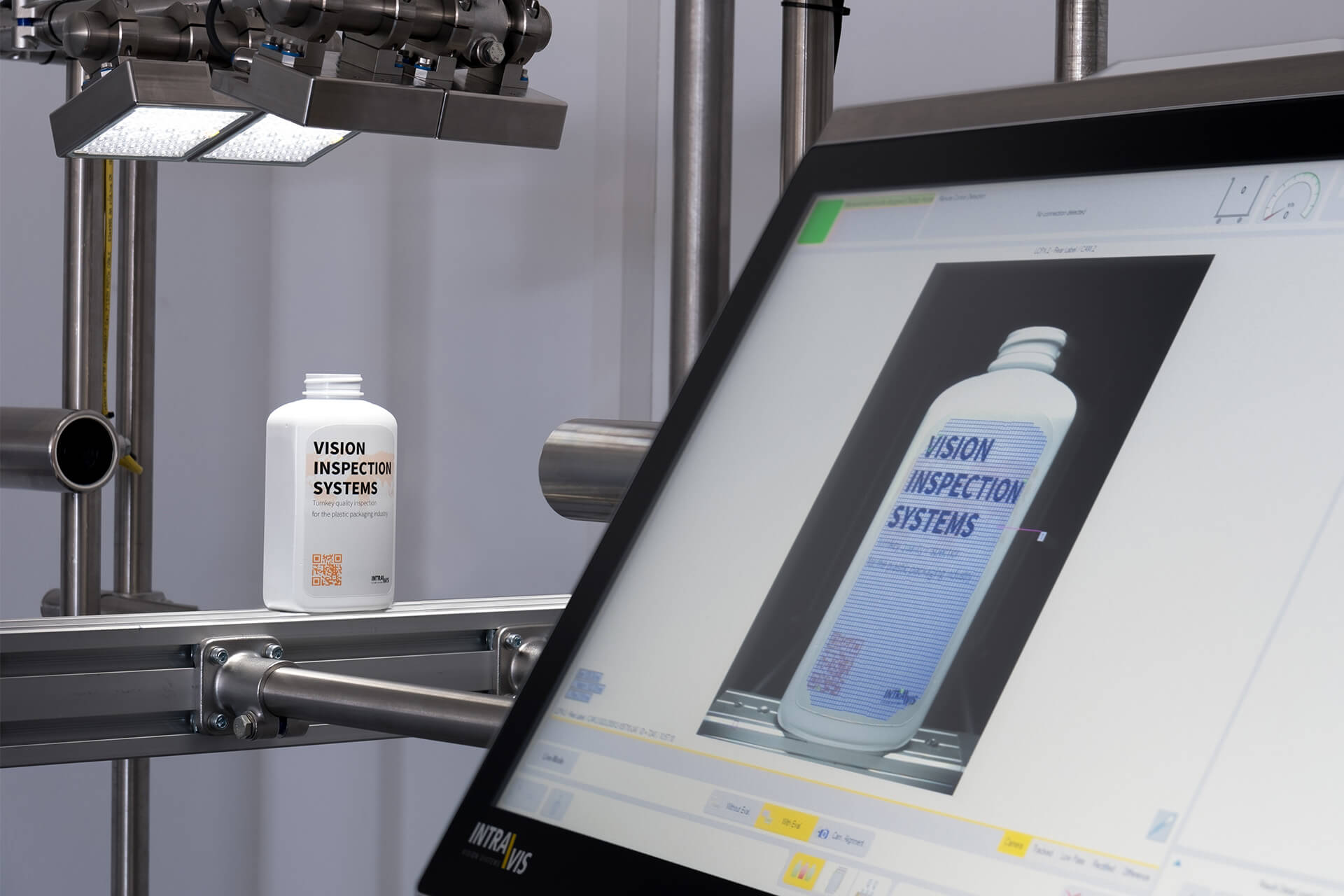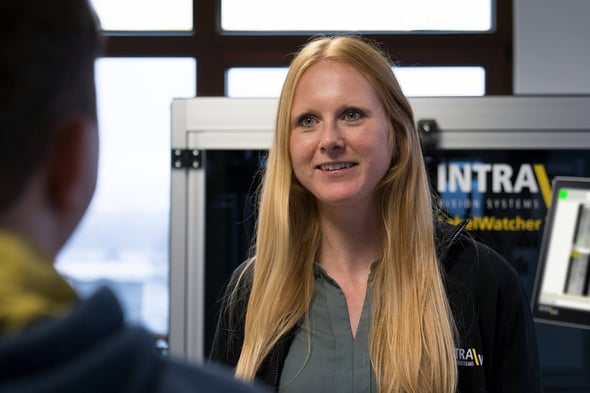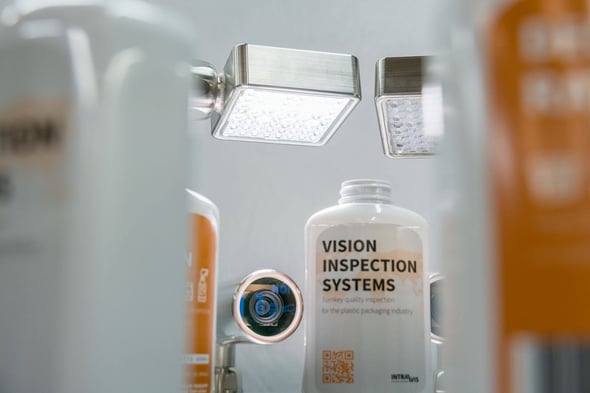INTRAVIS presents all-new LabelWatcher

Our LabelWatcher was relaunched this year. To mark the occasion, we met with Janina Orlowski, Group Leader of Product Management & PR as well as Product Manager responsible for decoration inspection systems, to find out what has changed and why it was necessary in the first place.
INTRAVIS: Janina, our LabelWatcher was relaunched this year. Why was that necessary?
 Janina: The basic idea has remained the same: The LabelWatcher continues to inspect labels. In the past, this could be any type of label. In the meantime, we have expanded our product portfolio in the Decoration & Labeling area so that we have various inspection systems that focus on different label types and their specific defects. For example, we have the IMLWatcher for in-mold labels, the SleeveWatcher for sleeve labels and the LabelWatcher 360° for wrap-around labels that is applied to an unoriented product. The LabelWatcher concentrates instead on typical errors of self-adhesive labels that normally occur on a front and back label. The LabelWatcher is often integrated directly into the labeler, which is particularly space-saving. However, an inspection set-up on the belt behind the labeler is also possible.
Janina: The basic idea has remained the same: The LabelWatcher continues to inspect labels. In the past, this could be any type of label. In the meantime, we have expanded our product portfolio in the Decoration & Labeling area so that we have various inspection systems that focus on different label types and their specific defects. For example, we have the IMLWatcher for in-mold labels, the SleeveWatcher for sleeve labels and the LabelWatcher 360° for wrap-around labels that is applied to an unoriented product. The LabelWatcher concentrates instead on typical errors of self-adhesive labels that normally occur on a front and back label. The LabelWatcher is often integrated directly into the labeler, which is particularly space-saving. However, an inspection set-up on the belt behind the labeler is also possible.
Focusing on PS labels ensures that label inspection is even more accurate. It is not only the inspection software that plays a role here, but also several hardware components. As part of the relaunch, we have also picked up a number of trends that are becoming increasingly relevant across all industries. These include M2M communication in the area of Industry 4.0 and data connection with regard to a cloud solution. The reliable reading and saving of codes is also playing an increasingly important role in ensuring traceability throughout the entire production process.
What has changed compared to the previous version?
We have optimized the inspection module according to the characteristics of PS labels. It now covers all the typical defect criteria that can occur on a self-adhesive label, such as folds and bubbles, as well as distinguishing between label offset, print offset and print-to-cut offset. This also becomes clear for quality managers in comprehensive statistics and reports, which can be sent automatically via email at any time.
In addition, many small features have been added to our software to simplify the daily work of machine operators and quality managers. It is now possible to create an automated quick reference during active measurement operation. In addition, the effects of a new reference compared to a previous reference can be seen in some sample images. This allows the machine operator to assess whether the new reference leads to the desired adjustments before actively transferring it to measurement mode. In addition, a long-term image memory offers the option of saving images from the last few weeks or even months and displaying them in filtered form. The statistics on the user interface have also been expanded.
Another highlight is the code inspection, which we have completely revised and optimized. With the help of a new software solution, it is now possible to read QR codes, barcodes and data matrix codes anywhere in the camera image - even if the lighting is not perfect or the code is very small. The code is inspected with the same camera as the label, which is why no additional hardware or space is required in the production line.
A lot has also happened with regard to the hardware. The lighting concept in particular has been completely rethought. Based on our experience from 30 years of image processing, we have now started to develop our own light fields that are specialized for certain inspections. The LabelWatcher now uses INTRAVIS light fields that illuminate the label homogeneously from top to bottom and avoid reflections and over-exposure/under-exposure, but still allow defects such as wrinkles and bubbles to be detected. This optimizes the overall vision inspection and significantly reduces the false reject rate.
 We have been implementing Industry 4.0 applications for many years in order to minimize the rejection rate, reduce resource costs and optimize the entire production process. These possibilities have now been extended once again. Using various communication protocols (e.g. OPC UA or MQTT), data can be imported and exported - to a cloud or local customer database. This data is in turn used to positively influence the production process: for example, our LabelWatcher reports a predicted label offset to the labeling machine, which then automatically adjusts the label dispensing heads. Or the laser printer is controlled so that a code is not lasered onto an incorrectly labeled product in the first place. This prevents rejects in a timely manner and minimizes the rejection rate. True to our vision "We solve problems. Before they occur.".
We have been implementing Industry 4.0 applications for many years in order to minimize the rejection rate, reduce resource costs and optimize the entire production process. These possibilities have now been extended once again. Using various communication protocols (e.g. OPC UA or MQTT), data can be imported and exported - to a cloud or local customer database. This data is in turn used to positively influence the production process: for example, our LabelWatcher reports a predicted label offset to the labeling machine, which then automatically adjusts the label dispensing heads. Or the laser printer is controlled so that a code is not lasered onto an incorrectly labeled product in the first place. This prevents rejects in a timely manner and minimizes the rejection rate. True to our vision "We solve problems. Before they occur.".
Our washdown design, which we have already developed for the CapWatcher FC, is completely new. The LabelWatcher is equipped with splash-proof components that can withstand intensive cleaning methods. This applies not only to the structure consisting of light fields, cameras, rejectors and profiles, but also to the electrical cabinet. Even cleaning with a high-pressure cleaner is no problem.
All in all, the customer receives a turnkey system - as they are already used to from all other INTRAVIS systems. Commissioning and extensive training of the machine operators are carried out by our service technicians. In addition, our support is available 24/7 via various communication channels. Contacting us via WhatsApp is quick and easy, even in a noisy and hectic production environment. Incidentally, our latest evaluations have shown that nearly 90% of our service tickets are answered in less than 8 hours.
And what is your personal highlight of the new system?
It's the mix of all the innovations I mentioned! Overall, the system has become much more modular and can therefore be tailored much better to individual customer requirements. The huge range goes from a basic system that is as cost-effective as possible to a comprehensive solution that maps many other quality features in addition to label inspection and is even equipped with splash-proof hardware and an Industry 4.0 concept.
What can customers do who have an old LabelWatcher and would also like to have these solutions in their system?
Some new features can be updated quite easily on systems that are already running at the customer's premises. However, this varies from system to system. We are looking forward to receiving inquiries and will be happy to check individually which innovations can be implemented and at which costs.